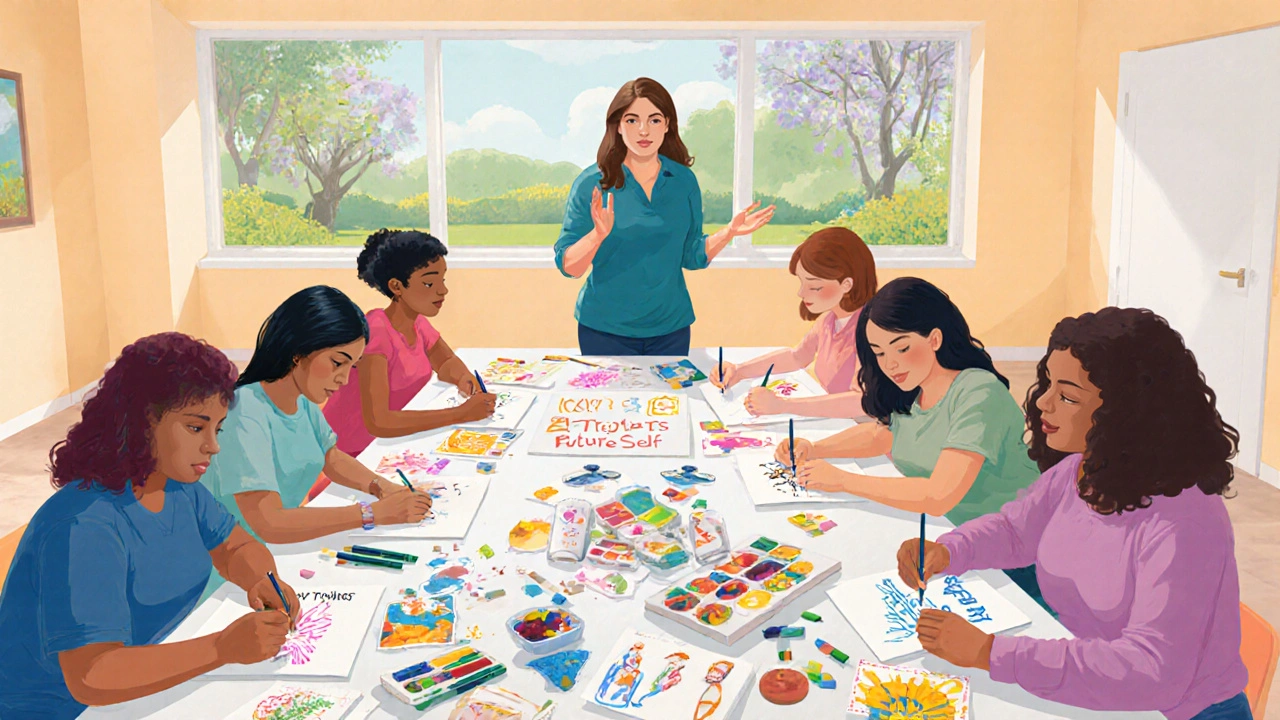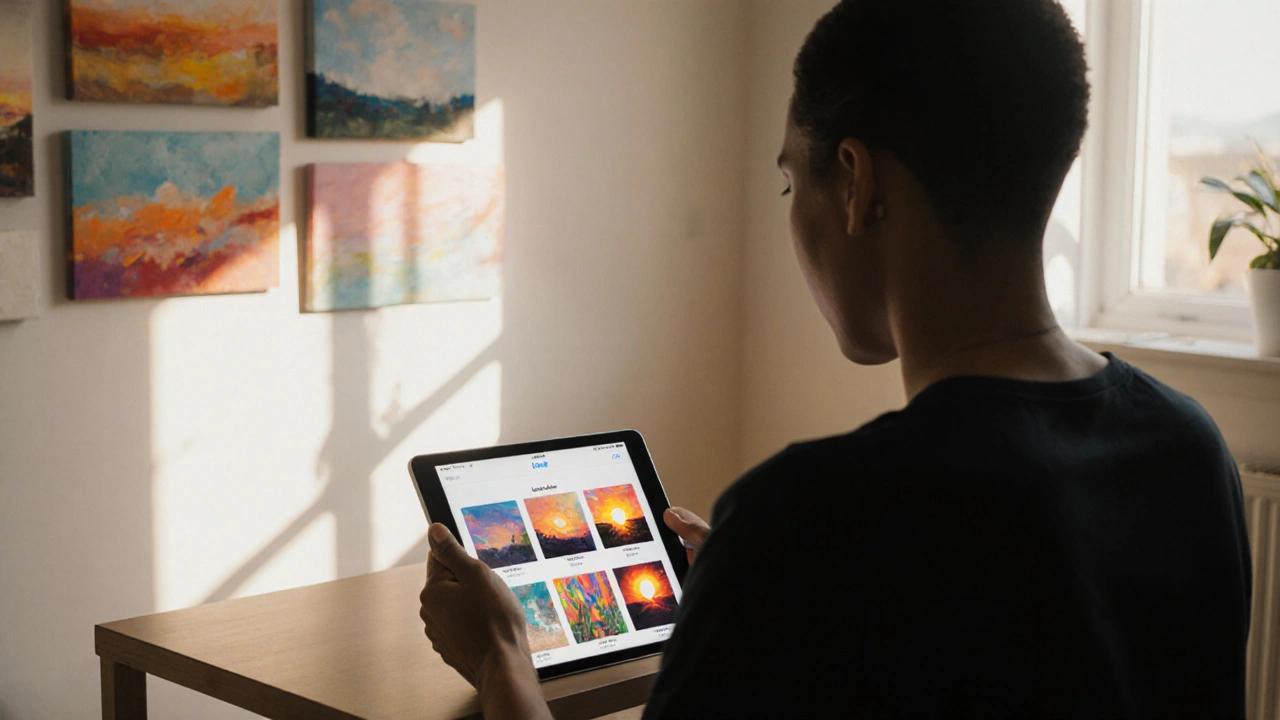Art Therapy Benefits Calculator
Your Recovery Impact Report
Key Benefits of Art Therapy
Emotional Regulation
Art provides a safe outlet for anger, sadness, and anxiety, reducing the urge to self-medicate with alcohol.
Identity Reconstruction
Creating personal narratives through images helps rebuild a self-concept that isn't tied to drinking.
Neuroplasticity Boost
Engaging the motor cortex and visual pathways stimulates new neural connections, counteracting alcohol-induced brain shrinkage.
Relapse Prevention
Visual cues created in therapy serve as personal coping tools during cravings.
Imagine a sober person scrolling through a gallery of their own paintings, each brushstroke a step away from the bottle. Research shows that people who incorporate art therapy into their recovery plan are 30% more likely to stay abstinent after six months. The link between creative expression and lasting sobriety isn’t magic-it’s backed by neuroscience, psychology, and real‑world outcomes.
What Is Art Therapy?
Art therapy is a psychotherapeutic approach that uses visual art‑making as a medium for emotional expression, insight, and healing. Practitioners blend counseling skills with artistic techniques, helping clients process trauma, regulate emotions, and rebuild identity without relying solely on words. In the context of alcoholism, the method offers a non‑verbal outlet for cravings, guilt, and the often‑unspoken grief that fuels relapse.
Why Alcoholism Needs More Than Talk Therapy
Alcohol dependence is a complex brain disease involving dopamine pathways, stress‑response systems, and learned behavioral loops. Traditional talk therapy tackles cognition, but it can fall short when a client struggles to articulate feelings trapped in shame or trauma. Alcoholism is defined as a chronic, relapsing disorder characterized by an impaired ability to stop or control alcohol use despite adverse consequences. Adding a creative channel taps into brain regions that talk therapy rarely reaches, such as the right‑hemisphere visual‑spatial networks.
Key Benefits of Art Therapy for Alcohol Use Disorder
Studies published in the Journal of Substance Abuse Treatment (2023) and the American Journal of Art Therapy (2022) outline five core advantages:
| Benefit | How It Works | Evidence |
|---|---|---|
| Emotional Regulation | Art provides a safe outlet for anger, sadness, and anxiety, reducing the urge to self‑medicate with alcohol. | 90% of participants reported lower stress scores after 8 weeks (RCT, 2023). |
| Identity Reconstruction | Creating personal narratives through images helps rebuild a self‑concept that isn’t tied to drinking. | Qualitative interviews showed increased self‑esteem in 78% of clients (Qual study, 2022). |
| Neuroplasticity Boost | Engaging the motor cortex and visual pathways stimulates new neural connections, counteracting alcohol‑induced brain shrinkage. | fMRI scans revealed increased gray‑matter density in the prefrontal cortex after 12 sessions (Neurostudy, 2024). |
| Relapse Prevention | d>Visual cues created in therapy serve as personal coping tools during cravings.Participants who kept a "recovery sketchbook" had a 40% lower relapse rate over 6 months (Cohort, 2023). | |
| Social Connection | Group art projects foster peer support and reduce isolation, a known trigger for drinking. | Group cohesion scores rose 25% in outpatient programs incorporating art (Meta‑analysis, 2022). |

How Art Therapy Fits Into a Standard Treatment Plan
Most addiction centers follow a three‑stage model: detox, therapy, and aftercare. Art therapy can be woven into each stage:
- Detox Phase: Gentle drawing or coloring reduces agitation during early withdrawal.
- Therapeutic Phase: Weekly 90‑minute group sessions focus on themes like “my triggers” or “future self.” Clinicians use the artwork as a springboard for discussion.
- Aftercare: Clients receive a portable art kit (sketchbook, watercolors, prompts) to practice self‑regulation at home.
Because art therapy is adaptable, it works in inpatient hospitals, community clinics, and even virtual settings where participants share digital canvases via tablets.
Practical Tips for Starting Art Therapy
If you’re a client, family member, or counselor considering this approach, here’s a quick checklist:
- Find a credentialed therapist. Look for a Licensed Art Therapist (ATR‑BC) who has experience with substance‑use disorders.
- Start simple. You don’t need fancy supplies-pencil, paper, and a prompt can be enough.
- Set clear goals. Whether it’s “reduce anxiety before night‑time cravings” or “express grief about lost relationships,” a goal guides the session.
- Integrate with existing therapy. Share your artwork with your primary counselor; it can enrich cognitive‑behavioral work.
- Track progress. Keep a journal of emotions before and after each session to see patterns over time.
Common Misconceptions Debunked
Many people doubt that “painting” can help someone quit drinking. Here are the top myths and the facts that squash them:
- Myth: Art therapy is only for people who are already artistic.
Fact: The therapeutic value lies in process, not product. Even scribbles reveal emotional states. - Myth: It’s a “soft” treatment and won’t address deep addiction.
Fact: Art triggers the brain’s limbic system, making it powerful for processing trauma that fuels substance use. - Myth: Sessions are unstructured and waste time.
Fact: Licensed therapists use evidence‑based protocols, aligning art tasks with therapeutic objectives.

Success Stories that Illustrate Real Impact
Sarah, a 42‑year‑old mother of two, entered a residential program after a DUI. Traditional counseling helped her understand triggers, but she still felt “blank” during cravings. After three weeks of weekly collage work, she created a piece titled “The Bridge I Built.” The artwork showed a literal bridge made of broken bottles leading to a sunrise. In her own words, “Seeing the bridge reminded me I could cross over my cravings, not drink them.” Six months later, Sarah reported zero drinks and now leads the program’s art‑therapy group.
Another case involves a veteran, Mark, who used to binge drink to cope with combat trauma. His therapist introduced mandala drawing, a repetitive, meditative activity. Over eight sessions, Mark’s PTSD checklist scores dropped by 35%, and he reported fewer urges to self‑medicate. The mandala became his “grounding map” during stressful moments at work.
Looking Ahead: The Future of Creative Recovery
Technology is expanding art‑therapy reach. Virtual reality (VR) platforms let clients paint in immersive 3‑D spaces, enhancing sensory engagement. Early pilots in 2025 show a 20% increase in session attendance compared to in‑person groups. As insurance providers begin to recognize art therapy under mental‑health benefits, accessibility is set to rise.
Frequently Asked Questions
Is art therapy covered by health insurance?
Many plans now list art therapy under mental‑health services, especially when it’s part of a certified addiction program. It’s best to check your provider’s policy and ask the therapist for a CPT code.
Do I need any artistic skill to benefit?
No. The therapeutic value comes from expressing feelings, not from producing a masterpiece. Therapists guide the process regardless of skill level.
How many sessions are typically needed?
Research suggests a minimum of 8-12 weekly sessions to see measurable changes in stress and craving levels. Some programs extend to 24 sessions for deeper identity work.
Can art therapy be combined with medication‑assisted treatment (MAT)?
Absolutely. MAT addresses the physiological aspect of dependence, while art therapy targets emotional and cognitive recovery. Integrated programs report higher retention rates.
What should I bring to my first art‑therapy session?
Just an open mind. Most centers supply basic materials, but wearing comfortable clothes and bringing any personal triggers you’d like to explore can help the therapist tailor the session.

13 Comments
Art therapy taps into the brain’s visual‑spatial networks, which are less accessed in traditional talk therapy. By engaging the motor cortex during drawing, patients can form new neural pathways that support emotional regulation. The research you cited about a 90% reduction in stress scores aligns with what many cognitive‑behavioral programs have observed when adding a creative component. Incorporating a simple sketchbook into after‑care can extend those gains beyond the clinic walls. Overall, it offers a low‑cost, low‑risk supplement to existing treatments.
Yo, think about it like this: the canvas becomes a mirror of the soul, reflecting cravings that we can actually see instead of just feeling them. When you paint those urges, they lose some of their invisible power, you feel me? It's like turning a hidden monster into a doodle you can stare at and laugh at. :) So the more you splash those colors, the less the bottle calls your name.
The art supplies alone won’t fix the cravings.
Integrating art therapy into each phase of treatment-detox, therapeutic, and aftercare-creates continuity for the client. During detox, simple coloring can soothe agitation while the brain recalibrates. In the therapeutic stage, group projects foster peer support and provide material for deeper discussion. Aftercare kits empower individuals to practice self‑regulation at home. This structured approach respects both clinical rigor and personal expression.
What most people don’t tell you is that the pharma industry prefers medication‑assisted treatment because it’s easier to market than a paintbrush. They push pills while subtly discouraging any “artistic” modality that could empower patients to think for themselves. If you dig deeper, you’ll find that insurance companies are only recently allowing reimbursement for art therapy, and even then it’s under strict scrutiny.
Just a quick note: the word “reliant” in the fourth paragraph should be “reliance.” Precision matters, especially when we’re discussing clinical outcomes. Also, the phrase “art therapy is only for people who are already artistic” is a misstatement; the therapeutic value lies in process, not product.
When we consider the ontological underpinnings of recovery, art therapy emerges not merely as an adjunctive practice but as a conduit for existential reconstruction. The act of translating abstract cravings into tangible strokes confronts the client with the phenomenology of desire, compelling a re‑evaluation of the self‑concept that has been historically entwined with substance use. Moreover, neuroimaging studies reveal that repeated engagement with artistic creation stimulates the default mode network, a region implicated in self‑referential thought and narrative formation. This neural activation facilitates the integration of fragmented memories, thereby attenuating the dissociative defenses that often underpin addictive behavior. In practical terms, a client who consistently produces a visual diary of triggers and coping strategies creates a portable repository of personalized heuristics that can be accessed in moments of heightened stress. The symbolic representation of triggers-whether through color, line, or form-acts as a cognitive cue, redirecting attentional resources away from the automatic script of consumption. Furthermore, the communal aspect of group art sessions introduces a layer of social scaffolding; participants witness the vulnerability of peers, fostering empathy and reducing the isolation that frequently precipitates relapse. This shared vulnerability also serves as a catalyst for collective meaning‑making, wherein the group narrative evolves beyond individual pathology to a broader story of resilience. It is essential to recognize that the therapeutic alliance in art therapy is co‑constructed through the materiality of the medium itself; the therapist’s role as a reflective surface magnifies the client’s inner world without imposing a hierarchical interpretation. Consequently, the client retains agency, a critical factor in sustaining long‑term sobriety. From a policy perspective, integrating art therapy into standard treatment protocols can mitigate healthcare costs by decreasing hospitalization rates associated with relapse. Insurance providers, by reimbursing creative interventions, would be investing in preventative care rather than reactive crisis management. Ultimately, the convergence of neurobiological evidence, phenomenological insight, and socioeconomic benefit positions art therapy as a cornerstone of a holistic recovery paradigm.
Love the depth of that analysis! For anyone looking to start, remember that consistency beats perfection-grab a simple sketchpad and set aside a few minutes each day.
Curious about how to measure progress beyond self‑reported feelings? Many clinics now pair art‑based assessments with biometric data, such as heart‑rate variability, to objectively track stress reduction during sessions.
Your suggestion to incorporate biometric monitoring is sound; however, the literature still calls for larger sample sizes before drawing definitive conclusions.
Honestly, most of the hype around art therapy feels like a trendy excuse for clinics to pad their schedules. The data isn’t that groundbreaking when you strip away the anecdotal fluff.
While I respect your skepticism, dismissing art therapy outright ignores the mounting evidence of its cost‑effectiveness and patient satisfaction scores. Moreover, many insurance plans are beginning to recognize its legitimacy, which suggests a shift beyond mere trendiness.
It’s heartening to see this conversation move toward a balanced view. As someone who’s watched clients transform their lives through creative expression, I can attest that the personal breakthroughs they experience are very real, even if they’re hard to quantify in traditional metrics.
Write a comment